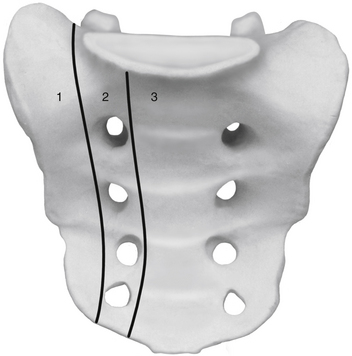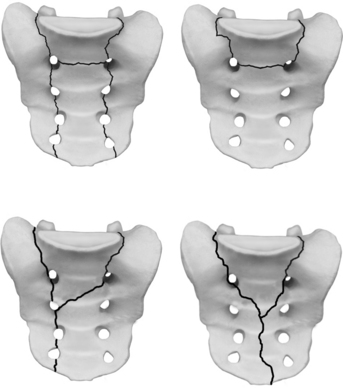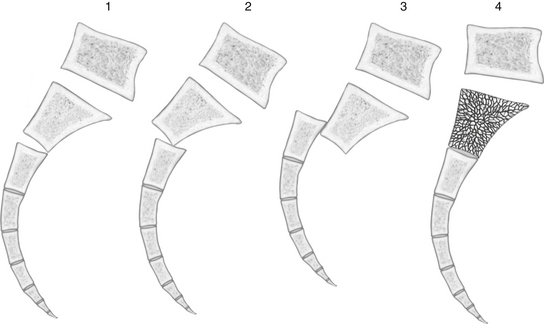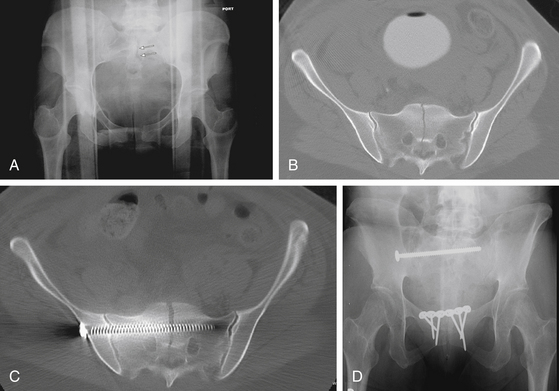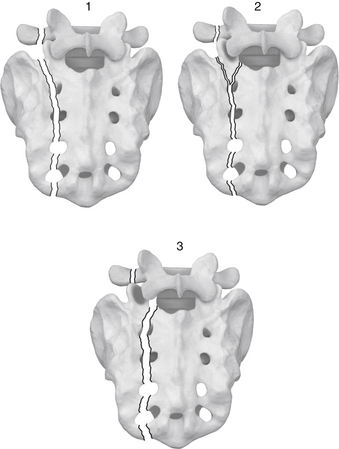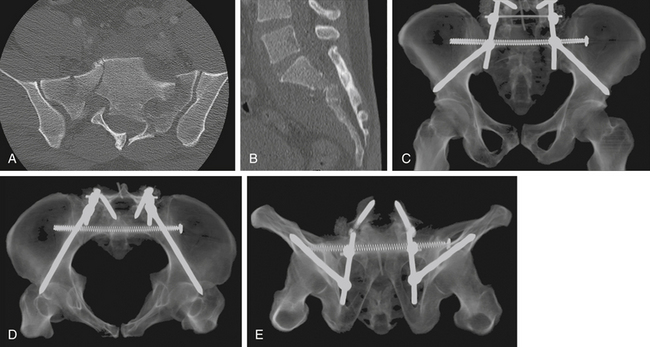Chapter 179 Management of Sacral Fractures
Anatomic and Biomechanical Considerations
The sacrum is the foundation of the spinal column, providing an anchor for the mobile lumbar spine. Compared to the remainder of the lumbar spine, the lumbosacral articulation is inherently more stable than more cephalad lumbar motion segments because of the presence of additional ligamentous stabilizers in the form of (1) the iliolumbar ligaments, which extend from the L5 transverse processes to the iliac crests, and (2) the sacrolumbar ligaments that originate contiguously with the iliolumbar ligament and insert into the anterosuperior aspect of the sacrum and sacroiliac joint.1
The sacrum has a forward inclination that is balanced by the usual lumbar lordosis, allowing a plumb line to normally extend from C7 to the posterior aspect of the L5-S1 intervertebral disc. The sacral inclination angle varies from 10 to 90 degrees and usually ranges between 45 and 60 degrees.2,3 Pelvic incidence, which measures the orientation of the lumbosacral junction relative to the pelvis, can be a valuable method for determining sagittal alignment when treating sacral fractures and is usually approximately 50 degrees.4 Sacral fractures that significantly alter spinal sagittal alignment may result in difficulty with maintaining an erect posture, compensatory lumbar malalignment, and associated pain and functional deficits.5
The sacrum also forms the posterior aspect of the pelvic ring and has therefore been described as the keystone of the pelvic ring,6 because it maintains stability while transmitting forces from the lumbosacral articulation across the sacroiliac joints to the pelvis. This keystone function is particularly true in the pelvic outlet plane, in which the orientation of the sacrum relative to the ilium is such that axial forces lock the sacrum into the pelvic ring and further stabilize the sacroiliac articulation. In the pelvic inlet plane, the sacrum is shaped like a “reverse keystone,” which is more inherently unstable and therefore requires substantial intrinsic and extrinsic ligamentous stabilization of the sacroiliac joints while permitting pelvic ring motion.7
The osseous sacral anatomy comprises five kyphotically aligned, fused vertebral segments, with significant variability in upper sacral anatomy in the form of transitional vertebrae and sacral dysplasia.8,9 Because upper sacral variability results in significant alteration in the relationships among the sacrum, pelvis, and spinal column relative to their adjacent neurovascular structures, these variations must be recognized, particularly if surgical treatment of sacral fractures is being considered.10
The upper sacral body has the densest sacral cancellous bone, particularly adjacent to the superior S1 end plate. The ventral aspect of the upper S1 body that projects anteriorly and superiorly into the pelvis is termed the sacral promontory. The sacral ala, the lateral portion of the sacrum that articulates with the ilium through the sacroiliac joints, is largely cancellous and is formed by the coalescence of the sacral transverse processes. The cancellous alar bone is hypodense, particularly in older individuals, and an alar void is a consistent finding in middle-aged and older adults.11,12 The relative difference in bone density between the upper and the lower sacral body predisposes this area to fracture. The hypodense ala is predisposed, particularly in older and osteopenic patients, to fracture line propagation. This problem is accentuated by the relative strength of the sacroiliac joint ligaments. Similarly, younger individuals injured before complete ossification of the sacrum are predisposed to disruption at the S1-2 level because of relative weakness at that interval. The suboptimal alar bone density must be taken into consideration when planning reconstructive procedures.
The posterior surface of the sacrum is convex and is formed by the coalescence of posterior elements. The middle sacral crest corresponds to the spinous processes, the intermediate sacral crests correspond to the zygapophyseal joints, and the area between corresponds to the laminae. The lowest one or two sacral segments have incompletely formed bony posterior elements, resulting in an aperture into the sacral spinal canal known as the sacral hiatus. Enlargement of the sacral hiatus may weaken the sacrum and predispose it to fracture.13
The dural sac typically ends at the S2 level, and the filum terminale attaches its caudal end to the coccyx. At the junction of the body and the sacral ala are four paired ventral and dorsal neuroforamina through which the ventral and dorsal rami of the sacral nerve roots pass. The relative space available to the sacral nerve roots in the ventral foramina is lowest at the S1 and S2 levels, where the nerve roots occupy one third to one fourth of the foraminal space, compared with the S3 and S4 levels, where the nerve roots occupy one sixth of the available foraminal space. The lower sacral roots are therefore less likely to be impinged upon in injuries involving displacement of the neuroforamina.14
The dorsal nerve roots exit through their respective posterior neuroforamina to supply motor branches to the paraspinous muscles and cutaneous sensory branches that form the cluneal nerves. Anteriorly, the L5 nerve root passes underneath the inferior edge of the sacrolumbar ligament and drapes over the anterosuperior aspect of the sacral ala.15 It anastomoses with the L4 ventral ramus and is joined by the exiting ventral sacral nerve roots as it passes caudally along the sacral ala to form the sacral plexus.16 The dual innervation of the perineal structures from both the left and the right sacral plexus is protective of bowel, bladder, and sexual function. These functions are largely preserved in the event of unilateral transection of the sacral nerve roots, whereas bilateral transection causes complete loss of function.17
The presacral area has an extensive and highly variable vascular network. The middle sacral artery typically courses ventrally along the midline of the L5 vertebral body and the sacrum after branching from the aorta at the common iliac bifurcation. The common iliac arteries subsequently give rise to the internal iliac arteries that lie anterior to the sacroiliac joints and give off both superior and inferior lateral sacral arteries. The superior lateral sacral artery courses caudally, just lateral to the sacral foramina, and supplies the spinal canal through the S1 and S2 ventral foramina, whereas the inferior lateral sacral artery traverses the inferior aspect of the sacroiliac joint before anastomosing with the middle sacral artery and giving off spinal arteries that pass through the S3 and S4 ventral foramina.9 The internal iliac veins lie posteromedial to the internal iliac arteries and course caudally. They are located medial to the sacroiliac joint directly adjacent to the sacral ala.15 The internal iliac veins give rise to an extensive presacral venous plexus, formed by anastomoses between the lateral and the middle sacral veins that communicate transforaminally with the epidural veins in the spinal canal.1,8,18 This extensive vascular network renders anterior exposures to the sacrum impractical and perilous.
Classification
Although several sacral fracture classification systems have been proposed,19–21 none was widely adopted until 1988, when Denis et al. described an anatomic classification that correlated fracture location with the presence of neurologic injury.14 This classification divides the sacrum into three zones (Fig. 179-1). Zone I (alar zone) fractures remain lateral to the neuroforamina. Zone II (foraminal zone) fractures involve one or more neuroforamina while remaining lateral to the spinal canal. Zone III (central zone) fractures involve the spinal canal. Denis et al. observed a greater likelihood of neurologic injury as fractures occurred more medially. In their series, zone I fractures had a 5.9% incidence of neurologic injury, primarily to the L5 nerve root as it courses over the ala. Zone II fractures had a 28.4% incidence of neurologic injury due to either foraminal displacement, and resulting impingement on the exiting nerve root, or “traumatic far-out syndrome,” in which the L5 nerve root is caught between the L5 transverse process and the displaced sacral ala. Zone III fractures had a 56.7% incidence of neurologic deficits resulting from injury within the spinal canal, with 76.1% of these individuals having bowel, bladder, and sexual dysfunction. Although Denis et al. noted a broad spectrum of zone III sacral fracture–dislocations, including the presence of both transverse and longitudinal fracture line orientations, zone III sacral fractures were more formally characterized by other authors, as described next.
Gibbons et al. studied 44 cases of sacral fracture according to the Denis classification system and found a 34% incidence of neurologic injury. They used these results as a basis for classifying neurologic injury caused by sacral fractures,22 which they classified as 1, none; 2, paresthesias only; 3, motor loss with bowel and bladder intact; and 4, bowel and/or bladder dysfunction. They reported neurologic injury in 24% of zone I injuries, 29% of zone II injuries, and 60% of patients with zone III injuries. Neurologic deficits with zone I and II injuries involved primarily the L5 and S1 roots. While no patient with zone I or II injuries had bowel or bladder dysfunction, two of the three patients with zone III injuries and neurologic deficits had bladder dysfunction. Though useful, this classification system may be insufficiently detailed to be meaningful as a clinical outcomes measurement tool.
Because of their neurologic and biomechanical implications, Denis zone III fractures have been further categorized by several investigators. Review of various series and case reports reveals a high likelihood of neurologic deficit characterized as cauda equina injury affecting lower extremity, as well as bowel and bladder, function.20,21,23–36
Early case reports often characterized the zone III injury pattern as solely a transverse fracture, possibly because of imaging limitations. Computed tomography (CT) demonstrates that most transverse fractures of the upper sacrum have complex, three-dimensional fractures patterns. The majority of these injuries are now understood to consist of a transverse fracture of the sacrum with associated “longitudinal” or “vertical” transforaminal and/or alar fractures that extend rostrally to the lumbosacral junction to form the so-called U fracture and its variations (e.g., H, Y, and lambda fracture patterns) (Fig. 179-2). These fractures are also characterized by a high incidence of L5 transverse process fractures, indicating disruption of the iliolumbar ligament.33
Roy-Camille et al. reported a series of 13 patients with transverse sacral fractures, which they classified as type 1, flexion deformity of the upper sacrum (angulation alone); type 2, flexion deformity with posterior displacement of the upper sacrum (angulation and posterior translation); and type 3, anterior displacement of the upper sacrum without angulation (anterior translation alone). Based on cadaveric studies, they hypothesized that types 1 and 2 were caused by impact with the lumbar spine in flexion, whereas type 3 fractures were caused by impact with the lumbar spine and hips in extension.37 Strange-Vognsen and Lebech added the type 4 injury, theorizing that comminution of the upper sacrum without significant angulation or translation was caused by impact with the lumbar spine in the neutral position38 (Fig. 179-3). A type 5 direct impalement–type injury has recently been proposed by Schildhauer et al.39
Other patterns of zone III sacral fractures have been identified as resulting from specific mechanisms or having predictable patterns of associated injuries. In contrast to transverse Denis zone III sacral fractures, midline longitudinal Denis zone III sacral fractures, in which the sacrum is disrupted through the sagittal plane, have a low incidence of neurologic injury (Fig. 179-4).40–42 This injury, was originally reported by Wiesel et al. in 1979, who suggested that the lower incidence of neurologic injury compared to transverse fractures is the result of nerve roots being subjected to a lateral displacement force rather than a shear force.42 Bellabarba et al. subsequently described this injury as a variant of the anteroposterior compression pelvic ring injury, in which none of their series of 10 patients had neurologic deficits, in contrast to the high incidence of neurologic injury reported in patients with predominantly transverse sacral fractures involving the spinal canal.40
Isler demonstrated that, even in the absence of a transverse fracture line, sacral fractures can be associated with spinal column instability. He described variations of longitudinal sacral fractures through the S1 and S2 neuroforamina that result in L5-S1 instability because of facet joint disruption43 (Fig. 179-5). Injuries with the fracture line lateral to the S1 articular process are not associated with instability of the lumbosacral articulation since the L5-S1 articulation remains continuous with the stable component of the sacrum. Fractures that extend into or medial to the S1 articular process, however, may disrupt the associated facet joint and potentially destabilize the lumbosacral junction. Complete displacement of the facet joint can cause a locked facet joint, making sacral fracture reduction difficult with closed methods alone. Facet disruption may also cause post-traumatic arthrosis and late lumbosacral pain.
In contrast to sacral fractures that occur as a result of high-energy mechanisms of injury, the precipitating event in sacral insufficiency fractures is often not identifiable or may be related to a fall onto the buttocks from a standing or sitting position. These injuries typically occur in postmenopausal women due to osteoporosis. Conditions contributing to osteoporosis are often present, such as chronic corticosteroid use or a history of radiation therapy to the pelvis (Fig. 179-6).27,44 The presenting symptoms are often vague and consist of poorly localized low back pain that may be exacerbated by sitting and standing. These fractures are typically oriented vertically and occur through the ala adjacent to the sacroiliac joint. There may also be a transverse component resulting in more complex U-fracture variants. Although neurologic deficits are uncommon under these circumstances.45,46 cauda equina dysfunction has been reported and neurologic status must be carefully considered.47
Mechanical factors related to the transfer of forces from the lumbosacral spine to the pelvis may also cause sacral insufficiency fractures in patients with osteoporosis.38 Pelvic stress concentration as the result of lumbosacral spine fusion has been described,48 and sacral insufficiency fractures caudal to lumbosacral fusions are increasingly being reported. These fractures probably represent inability of the sacrum to withstand forces concentrated there as a result of the large cephalad lever arm.49–53 Unilateral sacral insufficiency fractures may also occur on the concave side of lumbar scoliosis.45
Evaluation
Although sacral fractures are increasingly being seen in patients with osteopenic bone disorders that predispose a patient to pathologic fractures, they are usually the result of high-energy trauma. Diagnosis is frequently delayed, which may result in further displacement or neurologic deterioration. In a study that predates more routine use of abdominopelvic CT for the evaluation of trauma patients, Denis et al. found that in neurologically intact patients, the diagnosis of sacral fracture was made during the initial hospitalization only 51% of the time. The presence of a neurologic deficit increased the diagnostic accuracy to only 70%. The etiology of missed sacral fractures is multifactorial and ranges from difficulty identifying these fractures on screening anteroposterior pelvis radiographs, combined with the presence of distracting injuries in the trauma patient, to low clinical suspicion in patients with insufficiency fractures.14,54
The transfer of energy resulting in a fracture of the sacrum often causes other injuries, including life-threatening head and thoracoabdominal trauma. In these trauma patients, emergent resuscitation is the top priority. Accordingly, resuscitation is focused on maintaining cardiopulmonary and hemodynamic stability.55 The secondary survey includes screening evaluation of both the spinal column and the pelvic ring. Precautions to maintain spinal column integrity are necessary, and patients should be initially maintained on a flat surface and log-rolled from side to side to prevent spinal column displacement. Evaluation includes inspection and palpation of the patient’s back from the occiput to the coccyx. Clinical findings associated with sacral fractures include skin discoloration or laceration, palpable step off or crepitus, and ballotable fluid in the lumbopelvic region. Significant soft-tissue contusion or internal degloving analogous to the Morel-Lavallée lesion can have important implications on subsequent treatment.56 Rectal and vaginal examination, including the use of a speculum and proctoscope, allows detection of open sacral fractures and unrecognized neurologic deficits.
If pelvic ring disruption is associated with significant intrapelvic hemorrhage, provisional pelvic ring stabilization may be necessary to reduce pelvic volume and provide temporary stability. Available methods include application of a circumferential pelvic antishock sheet,10 pelvic clamp, anterior external fixator, or skeletal traction. Associated vascular injury, particularly to the hypogastric arterial system, may require embolization to adequately control arterial hemorrhage.57
Early detection of neurologic deficits is of paramount importance in patients with sacral fractures.58–60 A rectal examination is performed early in the evaluation of all multiply injured patients, even in the absence of obvious sensorimotor deficits in the extremities, to evaluate perianal sensation, anal sphincter tone, and voluntary perianal contraction and to assess for the presence of anal wink and the bulbocavernosus reflex. A straight-leg raise test may detect lumbosacral entrapment in the cognitively unimpaired. Extremity motor function is graded on a scale of 0 to 5 according to the American Spinal Injury Association scoring system, and a sensory level is obtained.
Fracture displacement can cause neurologic injury from several mechanisms, including angulation, translation, and direct compression by displaced bone fragments. Delayed neurologic deficits can occur from epidural hematoma, late fracture displacement, or callus formation19 and should be reinvestigated to determine its cause.
Several adjunctive methods can be used to evaluate the neurologic status of a patient with a sacral fracture. Electrodiagnostic studies may be useful in cognitively impaired patients, in differentiating upper motor neuron injuries or spinal cord injury from cauda equina injury in patients with intracranial or more cephalad spinal column injury, in the evaluation of patients with urinary tract injury, and for intraoperative monitoring.61 Pudendal somatosensory evoked potentials and anal sphincter electromyography (EMG) allow for evaluation of the sacral roots below the S1 level. EMG is limited in the acute setting because abnormalities may take weeks to emerge. For patients with neurogenic bladder, serial postvoid residuals or cystometrography is a useful diagnostic aid.
Increasingly common use of more sophisticated imaging techniques in the routine initial assessment of the trauma patient’s visceral injuries, such as CT of the abdomen and pelvis, has improved the early detection of sacral fractures. The identification of a sacral fracture on these studies mandates complete radiographic evaluation, including a dedicated fine-cut CT scan of the sacrum with sagittal and coronal reformations to allow the detail required for determining the fracture configuration, resulting instability pattern, and extent of sacral canal and neuroforaminal compromise (Fig. 179-7).66 Three-dimensionally reformatted CT scans may add insight into fracture morphology for less experienced clinicians or in the case of highly complex fracture patterns. Magnetic resonance imaging is not usually helpful except in cases of unclear neurologic deficits or discrepancies between skeletal and neurologic levels of injury, although it may provide early evidence of lumbosacral nerve root avulsion.67
< div class='tao-gold-member'>
Stay updated, free articles. Join our Telegram channel

Full access? Get Clinical Tree


